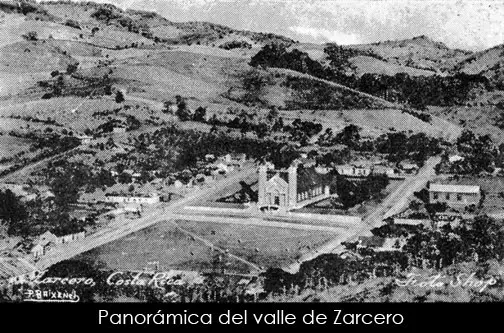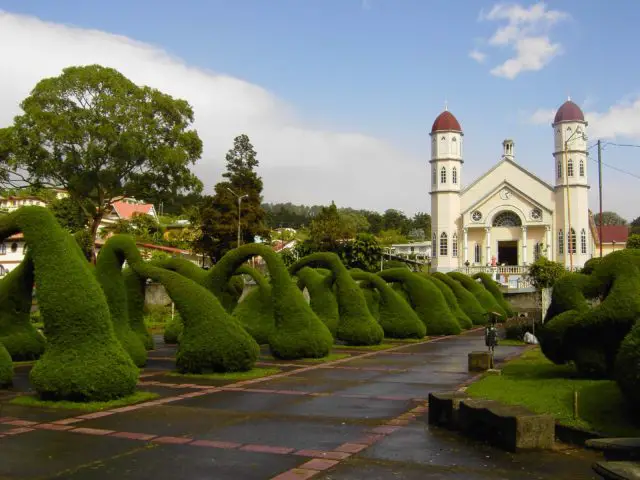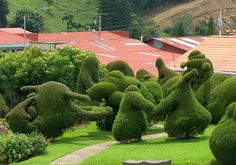The scenic town of “Zarcero” sits on the highlands of San José north of San Ramón in the Cordillera Central. This town is the capital of the canton of Alfaro Ruiz and one of the many Villas in the province of Alajuela.
With an elevation of 1,736 meters, Zarcero offers picturesque views of coffee plantations and quiet spaces for travelers to stop and rest. Its elevation is responsible for the cool weather so particular that makes this town so popular. It is also part of the agricultural area of Alajuela, where farmers take pride in their planting and harvesting practices. Being only 67 km from San José, anyone visiting La Fortuna and the Arenal Volcano can stop and get to know Zarcero and its rural peaceful atmosphere.
History

During the pre-Columbian era, the territory of the canton of Zarcero was inhabited by natives of the Huetar Kingdom of the West, at the beginning of the conquest it was the domain of the Garabito cacique (chieftain).
The first white settler who arrived in the region did so in 1854, it was José Zumbado, along with his wife Mercedes Solís; Three years later, Yanuario Cubillo arrived with his family, both from San José. Then the brothers Ramón and Adriano Blanco, neighbors of San Vicente de Moravia, as well as Judas Rojas, Feliciano Acuña, José María Brenes and Gordiano Murillo would come.
In 1886 the territorial school division of the Republic was established, in which Zarcero constituted the seventh school district of the canton of Naranjo. The first school building was built in 1914, in the first administration of Ricardo Jiménez Oreamuno; later it was baptized with the name of school Otilio Ulate Blanco. The Zarcero Institute began its teaching activities in 1969, under the government of José Joaquín Trejos Fernandez
In 1892 a small oratory was built, in the square of the current Church of Zarcero. By 1895, the parish of Zarcero is erected, being named San Rafael Arcángel as patron saint. The first water pipe was installed in 1910, under the government of Cleto González Víquez.
In the administration of Alfredo González Flores, on June 21, 1915, by Law No. 27, Zarcero was granted the title of the village, head of the canton created at that time. Subsequently, on July 24, 1918, during the government of Federico Tinoco Granados, Law No. 28 was enacted, which conferred the category of town.
On January 1, 1916, the first session of the Council of Zarcero was held, comprising the proprietary councilors, Mr. Francisco Alvarado Segura, President; Antonio Rodríguez Soto and Nicanor González Arguedas. The municipal secretary was Mr. Jesús Quirós and the political leader Mr. Ignacio Rojas Blanco.
In 1964, the municipality of the canton of Alfaro Ruiz commissioned Don Evangelista Blanco Brenes to maintain the town’s green areas in front of the church. On his initiative, Don Evangelista begins to give different shapes to cypress trees, gradually creating the emblematic figures that distinguish this park.
As of June 16, 2010, the name of the canton of Alfaro Ruiz becomes “Zarcero”, thus giving it the present name and by which it is widely known nationally and internationally, this is achieved thanks to a law discussed and approved in the Legislative Assembly.
The name of Zarcero comes from a plant, the sarsaparilla, very abundant and aromatic in the place. The name was changed from Alfaro Ruiz to Zarcero in 2010 because for many years, the name Zarcero was popularly the most used to refer to the town
Places to see

One of the main attractions of this town is the church of San Rafael, a beautiful building both inside and out. Those who appreciate good art will remain amazed by its religious paintings, architecture and colorful stained glass. Built-in 1895, this Zarcero church is composed of pieces of art such as a canvas on one of its murals made by Don Misael Solis Alvarado, a Costa Rican artist. The main entrance of the church of San Rafael is directly behind Francisco Alvarado Park, a park full of bushes and shrubs of different shapes, creations of Don Evangelista Blanco in 1964.
This gardener and curator of the park converted the bushes and trees of the park into impressive creations like animals, shapes, and people. After planting cypress seeds in the park, Don Evangelista waited a few years until they grew enough to shape them. Without any training in botany or gardening, this empirical artist has created wonders, from dinosaurs and helicopters to Jesus Christ carrying the Cross. Today, Don Evangelista continues to take care and cut the cypress trees of this park that only he keeps in immaculate condition.
Another attraction in this area of Zarcero is the Los Angeles Cloud Forest Reserve. This private park is a little secluded and is not very visited by tourists, making it the perfect place for a quiet getaway. With excellent trails and the opportunity to appreciate different species of wildlife, the reserve is located on land that once belonged to the former president of Costa Rica, Rodrigo Carazo.
The Poás Volcano National Park is one of the favorite attractions in the area. Being one of the largest active volcanoes in Costa Rica, the Poas rises 8,885 feet and is surrounded by 14,000 acres of parkland which is home to an impressive number of exotic flora and fauna. Some say this is the most impressive place to visit in the entire country. Its proximity with a large number of lodging and food options makes it a place of great attraction for tourists.
Weather
The climate of the canton is of the Central Valley type. Annual rainfall varies between 1500 and 3500 mm, and the average temperature is 17°C.
Economic activities

The canton of Zarcero is considered an important tourist destination in the country due to its artisan crafts and its parks. The main agricultural activities of the canton correspond to the cultivation of vegetables, fruit trees, coffee, and cattle. 37% of the land in the northern sector is permanent semi-forest, suitable for livestock or rational use of forest products. To the northeast and northwest of the canton, which constitutes 21% of the region, it has limitations such that it is only suitable for the rational use of the forest, through special extraction techniques.
7% of the cantonal area, in the western sector of the same, as in a small sector to the northwest, is used only to protect watersheds, wildlife and/or aesthetic purposes since it tends to erosion. 58% of the area of the region corresponds to an area with great mineral wealth like iron, zinc and copper sulfides, but mining is not allowed in the canton to preserve the pristine ecology of the area. To the northeast of the region, is located the “Juan Castro Blanco National Park” and to the southeast the “El Chayote Protective Zone”, which each cover about 3% of the surface of the canton.

